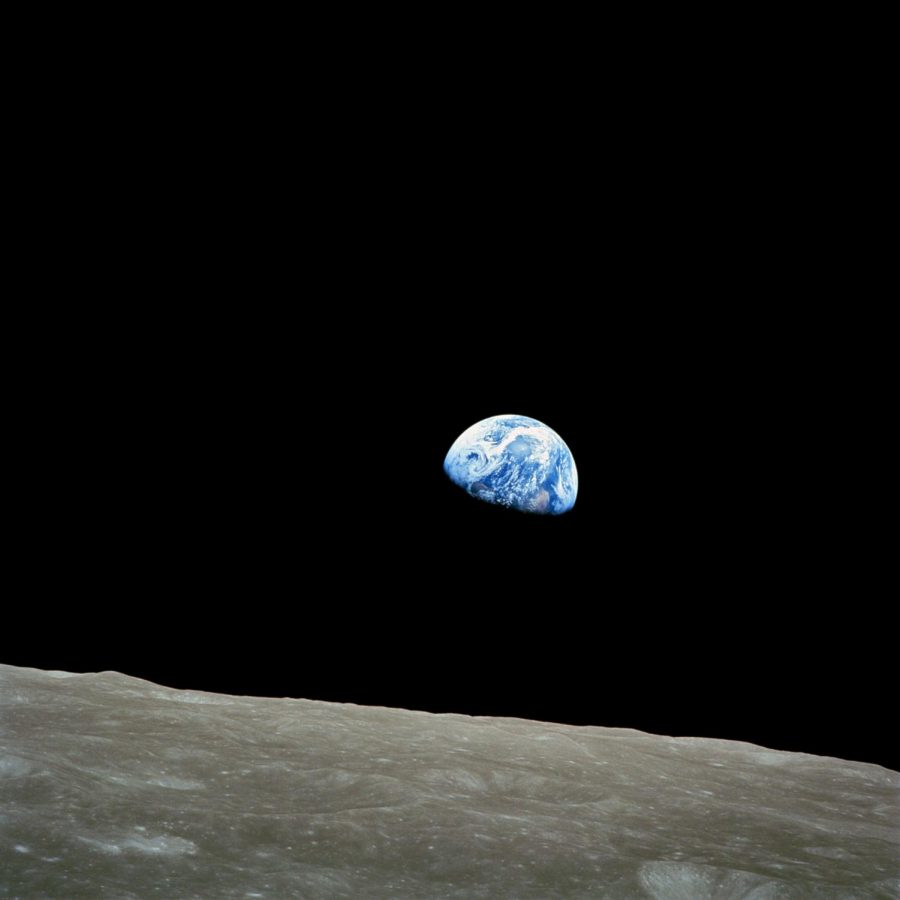Earth Day, Then and Now. Why you should take action on the 50th anniversary of Earth Day
Earthrise. Astronaut William Anders took this photo during his space exploration on December 24, 1968. Nature photographer Galen Rowell called the image “the most influential environmental photograph ever taken”.
April 22, 1970, the first Earth Day. Twenty million people across the United States mobilized in schools, universities, streets, and parks to demand action on environmental issues like air and water pollution, pesticide poisoning, waste and sewage management, and oil spills. This wave of grassroots activism not only led to great shifts in public opinion about the environment and the growth of the environmental movement, but it also created landmark legislation such as the Clean Air, Clean Water, and the Endangered Species Acts, and also established the Environmental Protection Agency (EPA).
Earth Day has since grown to be observed internationally by more than a billion people every year, and recognized as the largest secular observance in the world, according to Earth Day Network, an organization that rose out of the first Earth Day and coordinates the worldwide Earth Day events.
Fifty years after it was founded, Earth Day will occur this year amidst a time of unprecedented change and challenge. With nearly 2 million confirmed cases and more than 100,000 deaths, the COVID-19 pandemic has changed the lives of people and the activities of businesses, organizations, and governing bodies in every region of the world.
But while we work together to fight this pandemic, it is imperative that we do not ignore the biggest threat to our planet and future, the climate crisis. Just like what we have seen with the Coronavirus, the climate crisis will impact the most vulnerable groups in societies, disproportionately people of color and minorities. And it will also lead to new and exacerbated health problems for humanity. According to WHO, rising temperatures and the extreme climatic and weather events caused by the climate crisis are leading to the increased risk and occurrence of infectious diseases in many areas of the world. Similarly, melting permafrost in Arctic regions has the possibility of bringing back deadly viruses and bacteria that have laid dormant for thousands to millions of years.
With less than 10 years left to stop the climate crisis’s irreversible and most devastating effects, and the 26th Conference of the Parties to the United Nations Framework Convention on Climate Change (COP 26) being postponed to 2021, pressure on governments and institutions to make the “rapid and far-reaching” changes required to limit global warming to 1.5°C above pre-industrial levels must continue.
World leaders need to ensure that the recovery process from the COVID-19 pandemic includes an expeditious transition away from fossil fuels and to renewable energies. Moreover, countries like the U.S. should address issues in healthcare, labor laws, criminal justice, housing, education, and immigration to assist and protect those who are most impacted by sudden, large scale disruptions to economies and societies, including those fueled by the climate crisis like natural disasters.
But due to lockdowns and social distancing regulations, we cannot hold mass gatherings such as strikes this year on Earth Day. And that is why the Global Youth Climate Movement is taking it online.
We The Planet is organizing an international day of Digital Action on April 22 (Earth Day), working with activists, influencers, and media outlets to achieve the goal of keeping conversations about the climate crisis alive during the COVID-19 pandemic.
Watch this video to learn how to get involved.
Earth Day Network is hosting a 24-hour livestream on Earth Day and the US Youth Climate Strike Coalition, made up of organizations such as Earth Uprising, Zero Hour, and the Sunrise Movement, will continue the livestream for an additional two days, focusing on fossil fuel divestment and youth political engagement. The April 22-24 livestream will feature activists, celebrities, musicians, and leaders from across the U.S. and around the world and aims to educate, empower, and mobilize youth and adults alike to demand bold action in order to save the planet.
Click here to learn more and RSVP to the livestream.
Local groups are also mobilizing. The Hinsdale Climate Coalition has launched three online actions for Earth Day. First, a digital strike for which students can take a picture of themselves holding a self-designed poster to demand climate action. Second, a climate education themed live Kahoot on a Zoom call. And third, a TikTok competition for which students can create an Earth Day or Climate Change themed TikTok.
Click here for instructions on how to participate in the actions.
While we do our part to flatten the Coronavirus curve and save each others’ lives, we must also come together to call for immediate, robust action on the climate crisis. History has proven that when we stand together and fight for what is necessary and right, we will succeed. It may not be in the next day, week, month, or year, but change will eventually come. And in this fight against the single greatest existential threat facing us today, everyone is needed. Fifty years after the first Earth Day, let us show that we are united as global citizens in our vision for a liveable planet and future.
Mohammad Ahmadi is a 16-year-old Muslim-Iranian Youth Activist based in the Chicago metropolitan area who focuses on issues including climate change, immigration, islamophobia, gun control, and foreign policy. He currently works internationally with the non-profit, youth-led organization Earth Uprising. He can be reached at mohammad@earthuprising.org













